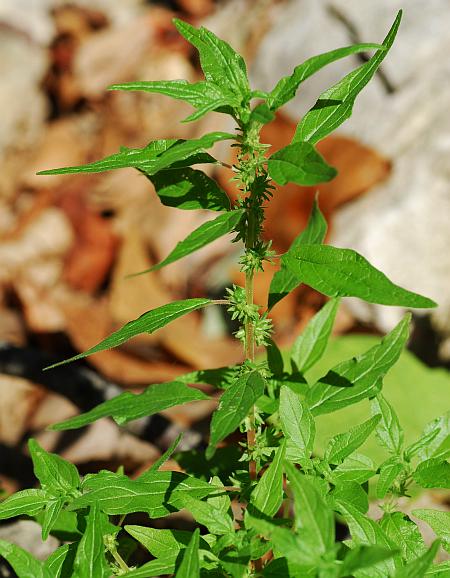Parietaria pensylvanica Muhl. ex Willd.
Pennsylvania Pellitory

Native
CC = 3
CW = 3
MOC = 60
© SRTurner
Parietaria pensylvanica Muhl. ex Willd.Pennsylvania Pellitory | |
 |
Native CC = 3 CW = 3 MOC = 60 |
© SRTurner |
|
Family - Urticaceae Habit - Taprooted annual, unarmed. Stems - To 50 cm, ascending to erect, sometimes sprawling on other vegetation, finely pubescent with minute nonstinging hairs.
Leaves - Alternate, petiolate, simple, lacking stipules. Blades to 7 cm, lanceolate to ovate or rhombic, tapered at tips, entire, with 3 main veins.
Inflorescences - Axillary, small, sessile clusters. Bractlets to 5 mm, exceeding calyces, linear, forming involucre around each cluster. Staminate flowers usually absent. Perfect flowers with 4 sepals, these 1-2 mm long, ascending to slightly incurved at the tips. Stamens 4. Pistillate flowers with 4 sepals fused to about the midpoint, these 1.5-2.0 mm long, equal. Style absent or minute, the stigma capitate, not persistent at fruiting.
Fruits - 0.9-1.2 mm long, symmetrically attached at the tip of a short, basally expanded stalk, flattened, the body ovate in outline, the surface smooth, tan to yellowish brown. Flowering - May - October. Habitat - Glades, ledges, savannas, forests, streambanks, railroads, disturbed areas. Origin - Native to the U.S. Lookalikes - Species of Acalypha, most notably A. virginica. Other info. - This small, non-stinging member of the nettle family often flies below the radar of wildflower enthusiasts. The flowers are minute and the plant generally inconspicuous. At a glance it is easily mistaken for a species of Acalypha (mercury), being similar in stature and appearance. There is a subtle but reproducible difference in leaf shape: Parietaria pensylvanica has leaves which are entire, long-tapered, often with slightly concave sides toward the tip, and tips which are blunt, whereas Acalypha leaves are toothed and convex all the way to the tip, which is sharply pointed. The inflorescences are also very different, but discerning this requires close scrutiny. The plant occurs throughout most of the state, and indeed throughout most of the continental U.S. Photographs taken at Tyson County Park, St. Louis County, MO, 8-29-2017 (SRTurner). |